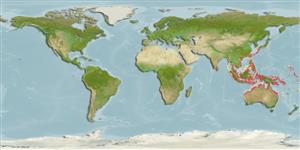Environment: milieu / climate zone / Tiefenbereich / distribution range
Ökologie
seewasser; süßwasser; brackwasser benthopelagisch; amphidrom (Ref. 46888); tiefenbereich 0 - 6 m (Ref. 90102). Tropical
Asia and Oceania: India, Hong Kong, Malaysia, Indonesia and Australia.
Size / Gewicht / Alter
Geschlechtsreife: Lm ? range ? - ? cm
Max length : 10.0 cm SL Männchen/unbestimmt; (Ref. 7050)
Rückenflossenstacheln (insgesamt) : 6 - 7; Rückenflossenweichstrahlen (insgesamt) : 11 - 12; Afterflossenstacheln: 1; Afterflossenweichstrahlen: 9 - 10. Characterized by pale grey to brownish body color grading to white on lower half; dark brown scale margins forming honeycomb pattern; presence of narrow dark brown to blackish stripe from rear edge of eye to above base of pectoral fin; dorsal and lower part of caudal fins with dark spotting; fully united pelvic fins with well developed frenum; rounded caudal fin, about equal to head length; longitudinal scale series 32-38; predorsal scales 12-16, reaching interorbital space; ctenoid body scales, becoming cycloid anterior to pectoral and pelvic fins; scales absent on cheek, 1-2 rows on anterodorsal part of operculum; depth of body 4.7-6.4 in SL (Ref. 90102).
Body shape (shape guide): elongated.
Inhabits sand or mud bottoms of estuaries and sheltered shoreline reefs in 0-6 m (Ref. 90102).
Life cycle and mating behavior
Geschlechtsreife | Fortpflanzung | Ablaichen | Eier | Fecundity | Larven
Genital papilla of male sometimes heavily pigmented, reaching anal spine. Genital papilla of female truncate, ending well short of anal spine.
Kottelat, M., A.J. Whitten, S.N. Kartikasari and S. Wirjoatmodjo, 1993. Freshwater fishes of Western Indonesia and Sulawesi. Periplus Editions, Hong Kong. 221 p. (Ref. 7050)
IUCN Rote Liste Status (Ref. 130435: Version 2024-2)
Bedrohung für Menschen
Harmless
Nutzung durch Menschen
Tools
Zusatzinformationen
Download XML
Internet Quellen
Estimates based on models
Preferred temperature (Ref.
123201): 24.7 - 29.3, mean 28.6 °C (based on 2826 cells).
Phylogenetic diversity index (Ref.
82804): PD
50 = 0.5005 [Uniqueness, from 0.5 = low to 2.0 = high].
Bayesian length-weight: a=0.00724 (0.00339 - 0.01546), b=3.10 (2.92 - 3.28), in cm total length, based on LWR estimates for this (Sub)family-body shape (Ref.
93245).
Trophic level (Ref.
69278): 3.4 ±0.4 se; based on size and trophs of closest relatives
Widerstandsfähigkeit (Ref.
120179): hoch, Verdopplung der Population dauert weniger als 15 Monate. (Preliminary K or Fecundity.).
Fishing Vulnerability (Ref.
59153): Low vulnerability (10 of 100).
🛈
Nutrients (Ref.
124155): Calcium = 292 [148, 635] mg/100g; Iron = 1.07 [0.55, 2.08] mg/100g; Protein = 16.9 [15.0, 18.5] %; Omega3 = 0.135 [0.046, 0.326] g/100g; Selenium = 28.5 [11.9, 64.1] μg/100g; VitaminA = 55.2 [16.3, 161.7] μg/100g; Zinc = 2.64 [1.80, 3.93] mg/100g (wet weight);
